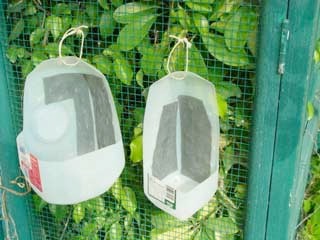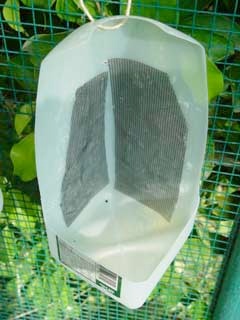



Hints and Tips - Troubleshooting
By Bill Strand
Citation:
Strand, B. (2003). Hints and Tips - Troubleshooting. Chameleons! Online E-Zine, January 2003. (http://www.chameleonnews.com/03JanStrandHints.html)
Hints and Tips - Troubleshooting
Over the years we gather experience and come up with special insights and interesting ways of attacking problems. I have jotted down some of these. While they don't seem to be worth writing an entire article on they should still get out! We decided we ought to just have an entry that consists of short hints and tips. This first installment consists of some things from my personal experience that may be of use. I would be very interested in things that others have come across. If you have any hints or tips regarding chameleon husbandry I would invite you to email them to me. If I compile enough good ones then we will run another installment!
1. Quick Feeder for tough customers
Bowl feeding is an attractive option because the food items do not escape. Unfortunately, some chameleons, especially new imports, do not take to bowl feeding very well. One method I came up with the help with acclimating wild-caught chameleons is to construct a bowl with a "cricket-run". The finished feeders are pictured below:


The feeder consists of a plastic milk jug with screening siliconed to the back and drain holes drilled in the bottom. This allows me to throw crickets and Zophobas into the bottom. Both the crickets and Zophobas will crawl around and latch onto the screen and climb up to the top. The motion of climbing atracts the chameleon's eye and appears more "natural" to it. This solves my problem of feeding shy chameleons because I get the appearence of a free climbing insect, yet still having the cricket confined. This works equally well in the home where crickets are not wanted to escape the cage as well as outside where we do not want the food items to disappear in the brush never to be seen or eaten. Many newly imported chameleons refuse to eat when a person is in sight. By using this method I was able to have an almost-free range cricket without me having to be there to supervise. The feeders pictured above have the advantage that they are cheap and quickly constructed and may be thrown away when they get dirty. It is no problem transferring this idea to a more aesthetically pleasing format for those so inclined. After all, my chameleons were outside and I hid the feeders in the trees.
To make this feeder as shown above wash out a milk or juice jug. Drill small holes in the bottom for drainage and where you intend to silicone the screen. The holes in the bottom should be as big as possible without allowing your food item to slip out. These holes make sure that rain or any other water will not fill the feeder up and drown your food items. I use standard window screening (not metal). Slather the silicone sealant over the area that the screen is to go. Place the pre-cut screen down and press it together. I usually use a piece of plastic I cut off of the plastic jug to run up and down the screen to press it against the silicone. This pressure should press the screen intot he silicone and squeeze the silicone out the holes in the back. Once it is out the hole it will expand slightly and when it dries will provide a strong anchor. Place the end of the screen close enough tot he bottom that the insects can reach it to climb up. Keep the screen far enough away from the edges so that the insect will not be able to reach the side and escape.
2. Handfeeding (get behind the food)
When handfeeding you will notice that the chameleon has one eye on the food item and one eye on you. So if you are trying to feed the chameleon and you have your arm outstretched to your side you are providing two things for the chameleon to look at. The chameleon needs both eyes on the food item to shoot it's tongue so make the job easier for it. Move your body behind the food item so the chameleon can focus both it's eyes on the food item and still keep you in sight.
Of course, there are many reasons why a chameleon feels nervous hand feeding from you, but if the chameleon is just on the verge of feeling comfortable feeding from your hand this hint may push it over the edge.
3. Place the cage above eye level
A chameleon pacing the cage is a chameleon that is not comfortable with it's environment. There are a myriad of reasons why this could be. Consider raising the cage so that the top comfortable perching branch in the cage is above your head level. Chameleons (generally) feel more secure up high. I have had nervous chameleons suddenly show absolutely no fear of me once they were placed above my head level.
4. Introduce a cricket to get breeding
This is one of the stranger ones, but...Sometimes when a female is introduced to the male's cage they do nothing but look at each other. When faced with this situation I send a cricket running through the cage. One of them will go for the cricket, and, for some reason, this disruption will break the tension and breeding starts. It doesn't work all the time, but it has worked enough times that I am willing to call it a hint!
5. Give a man his self-confidence
I once had a male Jacksons chameleon that had a self-esteem problem. I would put a female of an appropriate size with him and he would shrink away. She would show no agression, but he was acting the equivalent of a dog with his tail between his legs. Could it be due to the fact that he was the smaller of two males that were kept together for a while? He was the submissive one and just never seemed to snap out of it. I tried getting him in the mood by showing him another smaller male. This would send him running. This guy had a serious problem. I tried to give the guy some confidence by showing him another male from a distance and as soon as he got sight of the male I would take the intruding male away. I kept this up once a day showing the male longer and closer to the patient. Each time I would take the intruder away right at the point that the patient would make a move to turn and run. So each time the patient successfully "defended" his perching branch. I started using a mirror as I got got closer to the patient (no need to give my helper chameleon a loser complex). It only took about a week before the patient would stand and fight and appear ready to attack the mirror. The mating after that performance was successful.

Bill Strand

Bill Strand currently works in the area of exotic animal breeding and continues to refine husbandry techniques with a broad range of chameleon species. A special interest of his is the creation of captive environments. He was the Assistant Editor and Webmaster of this Chameleons! E-Zine from March 2002-March 2004.









Join Our Facebook Page for Updates on New Issues:
© 2002-2014 Chameleonnews.com All rights reserved.
Reproduction in whole or part expressly forbidden without permission from the publisher. For permission, please contact the editor at editor@chameleonnews.com
